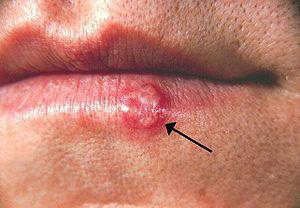Joseph R. Anticaglia MD
Medical Advisory Board
According to the World Health Organization, a mind-boggling 3.7 billion people under the age of 50 (or 67% of the world’s population) are infected with herpes simplex virus type 1 (see below). If you ever have had a fever blister or cold sore, you have been most likely infected with the HSV-1 virus.
Herpes simplex is a viral infection that does not leave the body. After being infected with the virus, it remains dormant in nerve cells until something, such as stress, triggers it to become active again. There is no cure for this disease.

Herpes simplex virus type-2 is responsible for most of the cases of genital herpes. Another staggering figure, an estimated 417 million people aged 15-49 (11%) worldwide has HSV-2 infection.
You might consider type-1 infection as occurring above the waist and type-2 below the waist. However, both viruses are closely related and either type-1 or 2 can cause herpes on the lips or genital region.
HSV-1 is mainly transmitted by oral-to-oral contact. Most of the lesions of type-1 infections are on the face or around the mouth.
HSV-2 is mainly a sexually transmitted infection that causes genital lesions. People with type-2 herpes increase their risk of acquiring HIV infection as well as getting sexually transmitted diseases
Herpes 1 and 2 are lifelong infections, most often asymptomatic and presently, there are no cures for this problem. Those infected with the herpes virus may experience recurrent symptoms in the same location for years.
Herpes outbreaks may be triggered by factors which include stress, sunburn, minor infections, trauma, fever, fatigue or changes in the hormonal or immune system.
Symptoms HSV-1
Herpes type 1 is highly contagious and most of the time individuals are unaware that they are infected. When symptoms occur, they might include flu-like symptoms, an itchy, burning or painful sensation in or around the lips and mouth. A group of tiny blisters break open, ooze and form a crust on your face.
Sores on the lips are referred to as “cold sores.” When the HSV-1causes genital lesions, the involved area may be painful, appear red with an itching and tingling sensation.
Symptoms HSV-2
Genital herpes, as noted, is almost exclusively sexually transmitted. Persons with type-2 herpes may have no symptoms or experience severe pain. Initially, there may also be flu-like symptoms. At times, mild tingling in the legs, hips or buttocks precede the discomforting genital lesions.
Small blisters in the genital area (penis or vagina) or anal region can rupture, ooze fluid producing sores with an itching, burning and stinging sensation. Lymph nodes in the region can become swollen and tender. The lesions usually crust over in one to two weeks.
The diagnosis is made by noting the person’s symptoms, by examining the patient and by obtaining viral cultures and special antibody slide tests. Once again, the disease is mainly transmitted for herpes type-1 by oral-to-oral contact and for type-2 during sex.
Complications
An eye infection (herpes keratitis) caused by the herpes simplex virus is worrisome. It can spread to one or both eyes. If this happens, you can have redness, discharge, pain, light sensitivity and a gritty feeling in the eye. Without prompt treatment, scarring of the cornea of the eye may cause cloudy vision and even loss of vision.
Neonatal herpes, although it occurs rarely, happens when the infant is exposed to the herpes virus in the genital tract during delivery. Genital herpes increases the risk of acquiring HIV. A person with both HIV and herpes type-2 is particularly prone to spread HIV to others. In addition, genital herpes may lead to social condemnation and psychological distress.
Treatment
Most cases of recurrent herpes are mild and do not require treatment. The lesions of type 1 and 2 usually crust and heal in one or two weeks. If treatment is needed, the antiviral acyclovir, in different formulations, has been used to treat herpes simplex.
Dr. Geraldine McQuillan reported the alarming prevalence in the United States of HSV-1 among persons 14-49 to be about about 47.8% and HSV-2 approximately11.8%. The virus does not go away; it stays in the body after the infection has resolved.
What is critical to recognize is the lifelong danger of this highly contagious and ubiquitous virus, take steps to prevent getting this disease, and if you have it, initiate treatment at the first sign of a recurrence.
References
- Geraldine McQuillan, Ph. D. et al; Prevalence of Herpes Simplex Virus Type 1 and Type 2 in Persons Aged 14–49: United States, 2015–2016; Center for Disease Control
- World Health Organization; Herpes Simplex Virus; January 31, 2017
- American Academy of Obstetrics and Gynecology; Genital Herpes; June 2019
This is intended solely as a learning experience. Please consult your physician for diagnostic and treatment options.

